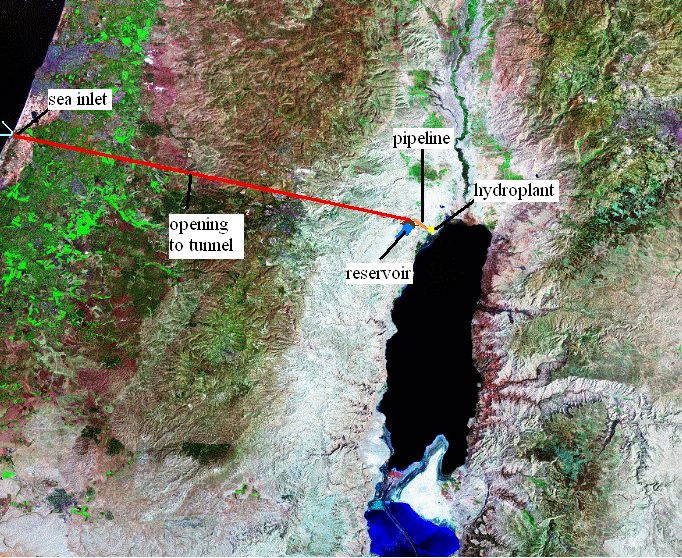| Design Concepts |
|
Introduction Basic Design Concepts The proposed design for the Dead Sea Water Project is for a below sea level bored tunnel, smooth bore concrete segment lined to produce an inside diameter of at least ten meters, constructed on a one in one thousand grade, to supply a maximum flow rate potential of approximately 400 cubic meters per second. This translates to a possible flow rate of twelve billion cubic meters per year. However, design flow rate will be about five billion cubic meters per year, with fifteen hundred megawatts hydroelectric capacity, utilizing a head pond reservoir to store water at higher elevation for peaking power. Using gravity flow is the most energy efficient design for the project, and it saves several hundred million dollars in construction cost by eliminating the intake pumping station that would be required by other project proposals.  The Dead Sea Water Project would supply more water than can be utilized with present infrastructure, but it is hard to imagine having too much water in a region where water supply is a central cause of conflict. Any potential resolution to the Palestinian peace plan will have to provide sufficient water for all the inhabitants of the region. The water use would be developed in stages, beginning with a hydroelectric and desalination facility near Ovnat on the north end of the Dead Sea. Water from the storage reservoir at the end of the tunnel, on top of the mountain, would be piped to the plants at the edge of the Dead Sea. Fresh water would be piped to Amman, Jerusalem, and the West Bank, as well as providing water for irrigation in the Jordan Valley in Israel and Jordan. Electric power would also be generated utilizing water used to fill the Dead Sea to the agreed 400 meters below sea level. Jordan would be expected to use the major part of the water available from the project. It is expected that Jordan will want to expand their water usage to accommodate the massive supply of potable water that will be available from the Dead Sea Water Project.  Additional desalination plants can be added to utilize the available flow and provide water for the Jordan Valley south of the Dead Sea. After the Dead Sea is filled to permanent level, all water flowing into the system will have to be used by evaporation in the Dead Sea, which will be about 1 billion cubic meters annually, and by supplying desalinated water for domestic, industrial, and agricultural use in the Jordan Valley. It is important to develop massive water use in the areas in the Jordan Valley more than 100 meters below sea level because water used there will provide energy for desalination and distribution as it passes through the hydroelectric plant. Additional Med seawater can be utilized for fish production in canals and ponds around the the Dead Sea. Jordan may develop wind power farms on the mountains east of the Jordan Valley, storing energy in pumped storage reservoirs on top of the mountain, and that power can be used for additional desalination. The filling of and evaporation from the reservoirs would increase the amount of water passing through the hydroelectric generators at Ovnat. Construction of a storage reservoir at the tunnel exit will enable the operation of a 1500 megawatt peaking power hydroelectric plant. Running the plant about eight hours daily, the level of the Dead Sea could be raised to the 400 meters below sea level elevation in about seven years after the project begins operation. The location of this large hydropower plant at the north end of the Dead Sea will facilitate the connection of the electric transmission grids of Jordan and Israel, connecting from Jerusalem to Amman. New Development- Med Sea Lake Assisted by the Geological Survey of Israel, the Dead Sea Water Project founder has located a proposed site for the storage reservoir for the tunnel flow, offering both increased value to the project from peaking power availability, and presenting an opportunity for settlement development in the Judean Hills around a Med Sea lake. The proposed reservoir site is south of the Wadi Kumran on the site outlined by the elevation lines from -30 to -80 meters below sea level. The proposed dam coordinates are from 627300 X 240300 on the north to 626500 X 241000 on the south.

http://www.mapatlas.org
|
